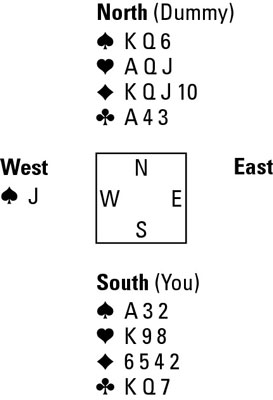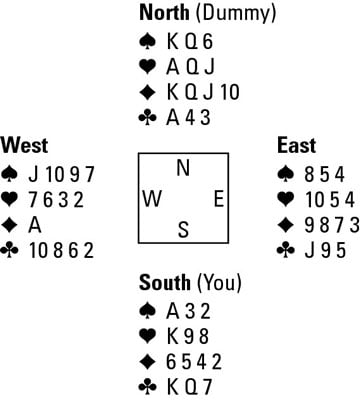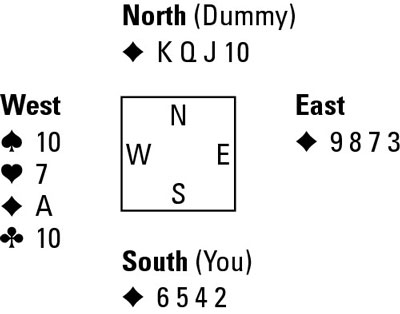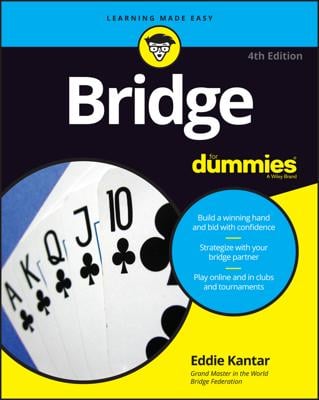Example
Say that you hold the entire hand shown in the example. Your final contract is for 12 tricks. West leads the ♠J. Now you need to do your thing and establish some tricks.
Before you even think of playing a card from the dummy, count your sure tricks:
-
Spades: You have three sure tricks — the ♠AKQ.
-
Hearts: You have another three sure tricks — the ♥AKQ. (Don’t count the ♥J; you have three hearts in each hand, so you can’t take more than three tricks.)
-
Diamonds: Sad. No sure tricks — no ace, no sure tricks.
-
Clubs: You have three sure tricks — the ♣AKQ.
When you need to establish extra tricks, pick the suit you plan to work with and start establishing immediately. Don’t take your sure tricks in other suits until you establish your extra needed tricks. Then, take all your tricks in one giant cascade.
Here’s how you’d play the hand in the example:-
First deal with West’s opening lead, the ♠J.
You have a choice. You can win the trick in either your hand with the ♠A or in the dummy with the ♠Q. Your objective is to establish tricks in your target suit: diamonds. Say that you decide to save your ♠A for later, and you take the ♠J with the ♠Q in the dummy.
-
Following your game plan, you lead the K from the dummy.
Pretend that West takes the trick with the ♦A and then leads the ♠10. Presto — your three remaining diamonds in the dummy, the ♦QJ10, have just become three sure tricks because you successfully drove out the ace. Your sure trick count has just ballooned from 9 to 12. Don’t look now, but you have the rest of the tricks and have just made your contract.
-
Capture West’s return of the ♠10 with the ♠K.
-
Take your three established diamonds, your three winning hearts, your three winning clubs, and finally your ♠A.
You now have 12 tricks, 3 in each suit. Ah, the thrill of victory!
How to avoid taking bridge tricks before establishing them
You may hate to give up the lead in a hand of bridge for fear that something terrible may happen. And you’re right. Something terrible is going to happen — if you’re afraid to give up the lead to establish a suit. Most of the time, beginners fail to make their contracts because they don’t establish extra tricks soon enough. Very often, beginners fall into the trap of taking their sure tricks before establishing tricks.Example
Of course, you’d never commit such a grievous error as taking sure tricks before you establish other needed tricks. But just for the fun of it, take a look at the example hand to see what happens when you make this mistake. This isn’t going to be pretty, so clear out the children.
In this hand, the opening lead is the ♠J, and you need to take 12 tricks. Say you play the hand like this:
-
You take the first three spade tricks with the ♠AKQ, then the next three heart tricks with the ♥AKQ, and finally the next three club tricks with the ♣AKQ.
This image shows what’s left after you take the first nine tricks (Remember: You need to take 12 tricks.)
-
You lead a low diamond.
West takes the trick with the ♦A. And now West has all the rest of the tricks! West remains with a winning spade, a winning heart, and a winning club. Nobody else at the table has any of those suits, so all the other players are forced to discard. West’s three cards are all winning tricks, and those great diamonds in the dummy are nothing but deadweight.

